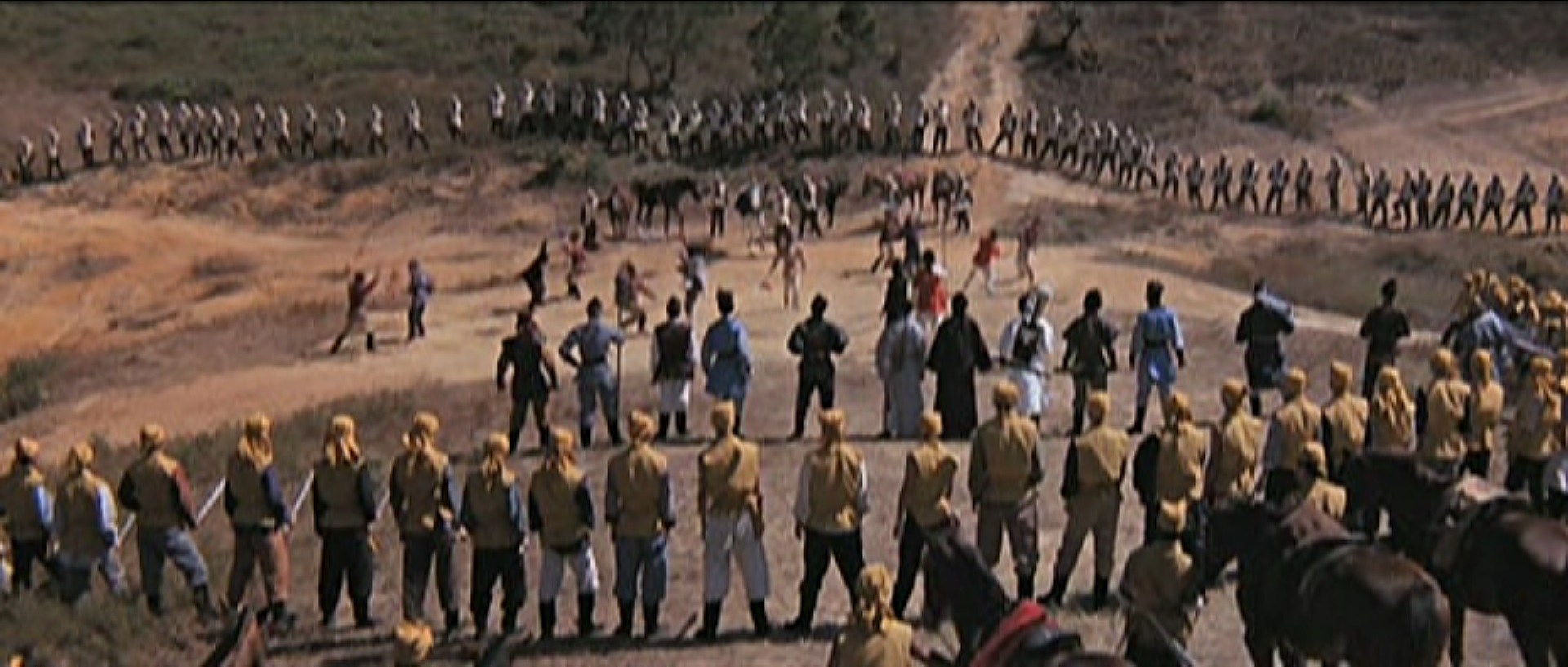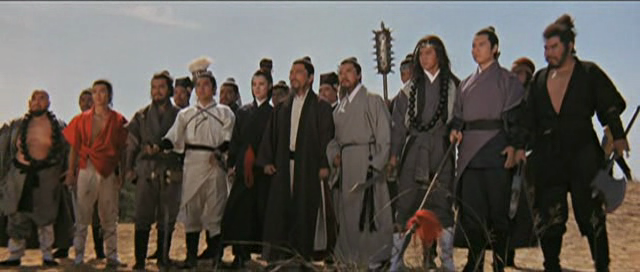
23 Aug THE WATER MARGIN: NAVIGATING THE DOUBLE-BLADED ASPECTS OF AN EPIC TALE
Whether it was under the title The Water Margin, Seven Blows of the Dragon, or Outlaws of the Marsh this film has certainly generated a strong reputation as one of the most ambitious pieces of cinema in the Shaw Brothers catalog. The response to the film though can be a bit more mixed than expected, particularly when the film features such a robust cast and crew of wildly beloved people from the studio. In my most recent viewing of the film, it’s easy to see why many fans see it as flawed when it takes many of the more treasured aspects of the studio style and slightly tweaks them, but it’s a film that is so ambitious that its ability to navigate the many pitfalls of its concept is impressive and admirable nonetheless. And it only covers chapters 64 through 68 of the epic novel that it’s based on. The Water Margin suffers slightly from the wicked double-bladed sword of attempting to be adapt a widely loved novel and maintaining the epic tone without sacrificing its ability to be consumed easily by the masses, but for the most part it handles it remarkably well. For this article, I wanted to dig into the film to see just how it attempts, accomplishes, or falters in this regard.
At the start, The Water Margin already has a lot of things going against it. Namely, it’s based on a wickedly thick text about 108 heroes and their various adventures. Already, as I’m sure most cinephiles hear from their book loving friends, there is going to be a large collection of people that disregard the movie for adapting the story already or go into it with a negative outlook. Maybe not so much in current times and outside of China, but it’s something that I’m sure the Shaw studio was aware of at the time and they do their best to address it as such. They were going to need to make the film easy to understand for those unfamiliar with the story, while maintaining the epic tone without much of the context. That’s a rough place to start and yet, The Water Margin dives right in and accomplishes quite a feat despite it.
This attempt to throw its audience into the 64th chapter does leave the opening sequence feeling a bit overwhelming. It has some text to explain to the audience that they are leaping right in, but then proceeds to spend ten minutes or so showcasing for the audience that what they are going to watch is epic in nature with lofty shots of dozens of extras and massive landscape visuals. The film introduces a slew of characters (with the name of actor along with their character name to show off its sublime cast) and continues to do so throughout most of the play time even after the initial binge. Often, it’s a bit irrelevant to the actual plot, but that’s beside the point for The Water Margin. It’s there for tone more than anything else and to let the audience know they are in for a journey where even the most minute detail and character maybe a relevant force to the plot and narrative.
Which is why, once the introductions are done and the initial plot of the first act is set up for us to follow some justice seeking bandits, it’s remarkable that the film pulls back to really focus on a couple of characters are the main protagonists and how all of those initial introductions are essentially secondary roles (even falling all the way down into glorified cameos.) Truthfully, this is a smart move by the writers and directors (there are three credited directors on the film and I’ve read places online that state both John Woo and Godfrey Ho were assistant directors on the project, even if most places simply give Chang Cheh the title credit) as it makes the entire plot and narrative much easier to digest. It also helps that the two characters are played by the ever-charming David Chiang and Tamba Tetsuro in two very different roles, but each one being easy to see as heroes and ones looking just do the right thing in a very complex situation. The rest of the cast pop in and out, thankfully played with enough spirit and energy to be decently memorable even in their limited screen time or anchored by how they fit into the more layered script, so having a two-character foundation works in this case to bring the audience in as outsiders. The tone is epic, as set up by the overstuffed first introduction to the film, but it quickly focuses down on two relatable characters within that the grand worldbuilding and it’s a smart maneuver to not overwhelm its audience and they now have a transition into the world.
As the film further plays out, it simply uses our two main protagonists to explore the established world, bouncing between various other sects of characters, but always returning to the main core plot – of saving Lu from the vicious authorities as they unjustly have him set up for execution. The wuxia themes of loyalty, brotherhood, and justice maintain a grounded sense of realism as things play out, but, much to the dismay of certain portions of the Shaw Brothers fandom, the film tends to use it for dramatic purposes rather than the more entertaining ones that the studio is accustomed to using. This plays into the film’s more sparsely spaced out action sequences, until the finale which goes full Chang Cheh violent and entertaining, that makes many fans claim the film to be too boring, long, and slow. However, each of the action set pieces, whether it’s David Chiang’s throwing showdown to impress some young ladies or the previously mentioned classic wuxia battle of the ending, all retain meaning and are placed rather impressively to keep the plot and narrative moving. There may not be as many over-the-top or outlandish moments of action that many fans expect, but that is part of what sets The Water Margin apart from its peers in tone and style. This is an epic made real and in that regard it feels much different at times even when it comes to action or character introduction.

In the end, it’s not shocking to see why there are mixed reactions by fans to The Water Margin. The film is much slower and longer in its pacing than the usual martial arts material from the Shaw Brothers and it intentionally pulls away from being too over the top and grounds itself in its characters, emotions, and narrative. Fans may not approve of that intentional approach. However, when it comes to navigating the trenches of adapting one of the biggest wuxia novels of all time, the blend of cohesive and focused character development and intentionally meticulous pacing only does the film good and it dodges pitfalls remarkably well. It’s a double-bladed sword wielded confidently and expertly with only some minor flaws to hinder its overall execution. Considering how many talents are involved in the film (so many directors and fight choreographers!) this film could have easily eaten itself into oblivion by overstuffing things or misunderstanding where the direction and focus of the film needed to go, but that’s not the case.
The Water Margin remains an expertly woven wuxia epic that features some of the Shaw Brothers most talented and screen grabbing creative forces for the time. If anything, it should be remembered for its ambition more than anything else, even if the rest of the film tweaks the style to get it there.
Written by Matt L. Reifschneider the Founder/Writer/Lead Editor of Blood Brothers Film Reviews. Unapologetically cult. Follow him on Twitter.
